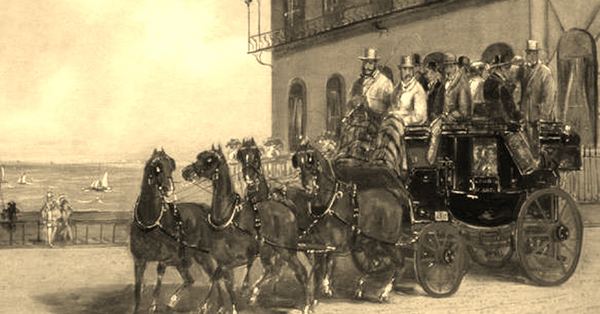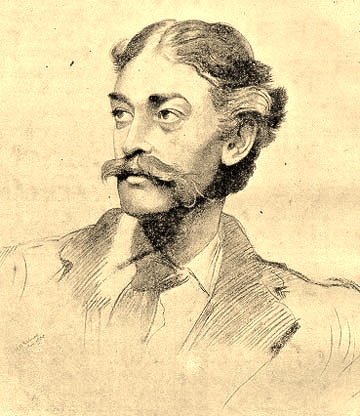
PARANORMAL ACTIVITY AT THE ROYAL ALBION HOTEL
Designed by Amon Henry Wilds, The Royal Albion Hotel, Brighton, opened its doors on July 27th, 1826. However, it was then known simply as the Albion, only acquiring the ‘Royal’ prefix in around 1847, due to the patronage of its distinguished guests and thus being conferred a royal coat of arms above the front entrance. This elegant building, with its grand Ionian and Corinthian columns, is unusual in that it faces inwards from the sea. This was due to the fact that visitors of the time preferred to look out onto the gardens of the Royal Pavilion, which then extended onto Old Steine.
The hotel was a resounding success during its early years. Sadly, by the turn of the century, the moneyed classed, who had initially popularised Brighton, had begun holidaying in more far-flung climes. Its fortunes began to dwindle and by 1900, having become dilapidated, it finally closed. However, its prosperity was restored in 1913 by the charismatic financer Harry Preston. Notable guests soon started flocking to the revitalised hotel, including Arnold Bennett, who began writing part of his Clayhanger trilogy while staying there in1910. Its stature continued with many authors, artists, actors and sportsmen residing there throughout the 1920’s and 30’s. In 1998 a serious fire broke out in the kitchen and spread through a ventilation shaft destroying rooms on the upper floors. The hotel was fully restored and is now owned by the Britannia Group of Hotels.
Needless to say, the hotel has a ghostly heritage and is said to be haunted by the ghost of it former financier Harry Preston. His presence had been most felt in the function room that bears his name. Many hotel guests and staff have spoken of extreme and unaccountable drops in temperature in this area. Other times people have witnessed the opening and closing of doors of their own volition, even when a chair has been jammed against the handle. The lift will also often begin moving up or down without any reason.
In 1989 a group of workmen were enjoying a tea break in the workshop beneath the Harry Preston room. The men were suddenly alarmed to hear the distinct clatter of what sounded like stones or pebbles being scattered about the floor beneath their feet. The men searched to see if any plaster or fittings had fallen from the ceiling, but could find nothing.
Earlier, in 1985, an engineer was working alone in one of the hotel suites only to be struck, quite severely, on one side of his head by an unseen force. He had certainly not imagined the incident as his ear remained swollen for several days thereafter.
Interesting, an unexplained coldness always seemed to permeate the room, even on warm summer days. At a later date the room was divided up into two smaller rooms. Interestingly, from that day on the temperature of the two rooms has remained quite normal.

The Royal Albion also harbours a dark and murky secret, created in 1888 by the mysterious death in one of the bedrooms, investigated in the book ‘The Strange Case of Edmund Gurney’. Gurney had been a frequent visitor to Brighton and arrived at the hotel on Friday 22nd June 1888.
That evening he dined alone and retired early. By two o’clock the following day he had not responded to repeated knocking, first by the maid and then the manageress. The door was subsequently broken open to find Gurney dead in his bed. His mouth and nose were covered by a sponge bag. A small bottle of colourless liquid was found by his bedside. It was known, however, that Gurney suffered from obstinate sleeplessness and occasional neuralgia, prompting recourse to opiates. Had this been a fatal error of judgment in the use of such opiates to induce sleep, or was he murdered?
His body was identified by a letter found in his coat, inviting a friend to join him. It has been suggested that the so-called friend was one Robert D’Onston Stephenson, a Walter Mitty type character who was a journalist and black magic practitioner. He was also alleged to have been a former army surgeon.
D’Onston, as he liked to be known, was, at that time, living at the Cricketers in Black Lion Street when it was a rather lowly drinking den with cheap accommodation. He has also come to be regarded as one of the main suspects for being Jack the Ripper. Ripperologist and author, Melvin Harris, firmly believed that Stephenson was the Ripper claiming “…alone, of all the suspects, had the right profile of opportunities, the motives and the ideal cover. His background, his personality, his skills, his frame of mind all (point to) him for the fateful role.”
It will never been truly known whether Stephenson was a murderer. But could it be the troubled spirit of poor Edmund Gurney, who met such a premature end, at the young age of forty one, that contributes to the paranormal activity at the hotel?
